 | | | Switch to: Europe, USA, New Zealand, Antarctica Credit: NOAA/Ovation  Planetary K-index Planetary K-index
Now: Kp= 0 quiet
24-hr max: Kp= 3 quiet
explanation | more data
Interplanetary Mag. Field
Btotal: 5.4 nT
Bz: 3.9 nT north
more data: ACE, DSCOVR
Updated: Today at 2350 UT  Coronal Holes: 17 May 19 Coronal Holes: 17 May 19 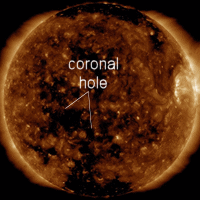
Solar wind flowing from these coronal holes should reach Earth on May 21st. Credit: SDO/AIA
 Noctilucent Clouds The northern season for noctilicent clouds is little more than a month away. The electric-blue clouds circling the north pole should return in mid- to late May. . Switch view: Europe, USA, Asia, Polar Updated at: 05-17-2019 14:55:05 Noctilucent Clouds The northern season for noctilicent clouds is little more than a month away. The electric-blue clouds circling the north pole should return in mid- to late May. . Switch view: Europe, USA, Asia, Polar Updated at: 05-17-2019 14:55:05  SPACE WEATHER
NOAA Forecasts | | Updated at: 2019 May 17 2200 UTC FLARE | 0-24 hr | 24-48 hr | CLASS M | 01 % | 01 % | CLASS X | 01 % | 01 % |  Geomagnetic Storms: Geomagnetic Storms:
Probabilities for significant disturbances in Earth's magnetic field are given for three activity levels: active, minor storm, severe storm Updated at: 2019 May 17 2200 UTC Mid-latitudes | 0-24 hr | 24-48 hr | ACTIVE | 10 % | 10 % | MINOR | 01 % | 01 % | SEVERE | 01 % | 01 % | High latitudes | 0-24 hr | 24-48 hr | ACTIVE | 20 % | 15 % | MINOR | 20 % | 20 % | SEVERE | 10 % | 15 % | | | |  | | | | | | | | | | | Special Offer: SAVE 600nok per person. Book a combination aurora borealis chase and scenic day tour during the months of September, October or November 2019 for the special price of 1800 kr. Check Marianne's webpage for details! | | | STILL WAITING FOR THE SOLAR STORM: Better late than never? CMEs expected to arrive on May 15th and 16th have not made themselves felt. Nevertheless, NOAA forecasters believe an impact may still be in the offing. There is a chance of G1-class geomagnetic storms on May 17th when at least one late-arriving CME reaches Earth. If this prediction is wrong ... well ... it's not the worst thing that happened this week. Aurora Alerts: SMS Text. MERCURY VISITS A STAR CLUSTER: Mercury is approaching the Pleiades for a rare conjunction between the first planet and a star cluster. Don't look, though! It's happening in the noon sky only degrees away from the blinding sun: 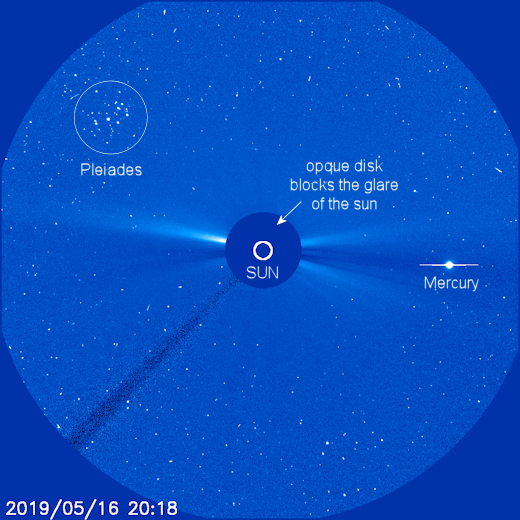
Human eyes can't see the conjunction, but the Solar and Heliospheric Observatory (SOHO) can. Coronagraphs onboard SOHO block the glare of the sun to reveal nearby stars and planets. Between now and May 20th, coronagraph images will track fleet Mercury swiftly approaching the daughters of Atlas. Join SOHO for a ringside seat.
Realtime Space Weather Photo Gallery
AN "X" IN THE SKY: Last week, Marcella Giulia Pace of Livinallongo Col di Lana, Italy, looked at the bright sun, then turned away, squinting. To her surprise, she saw a luminous X in the sky. Blinking didn't make it go away. "It was a rare Wegener Arc," she says. 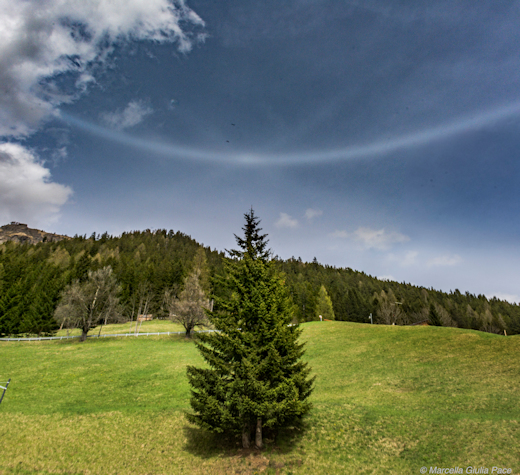
In the picture, above, the faint X-shaped Wegener Arc is bisected by a bright parhelic circle. They intersect just above the tip of the tree at a point in the sky directly opposite the sun. Wegener Arcs are caused by sunbeams passing through pencil-shaped ice crystals in the clouds. For the arc to form, the sunbeam must enter through one face of the crystal, bounce off the inside, then exit through another face tilted 60 degrees with respect to the first. No wonder they're rare. 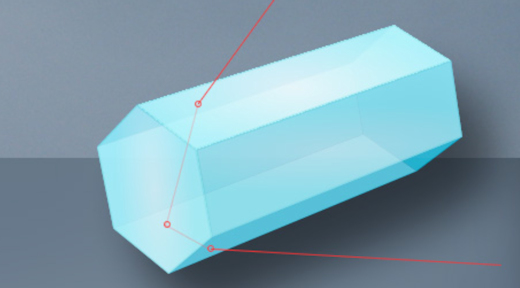
Above: The formation of the Wegener Arc. [more]
The bright parhelic circle is formed in a different way when sunlight shines through plate-shaped crystals. It is rare, too, but not as rare as the Wegener Arc. All in all, a lucky catch. "It made my day," says Pace. Realtime Space Weather Photo Gallery SPACE BASEBALLS FOR FATHER'S DAY: Father's Day is less than 4 weeks away. What do you get the dad who has everything? A space baseball, of course. This one flew to the stratosphere onboard an Earth to Sky Calculus cosmic ray balloon on Feb. 23, 2019, reaching an altitude of 95,423 feet: 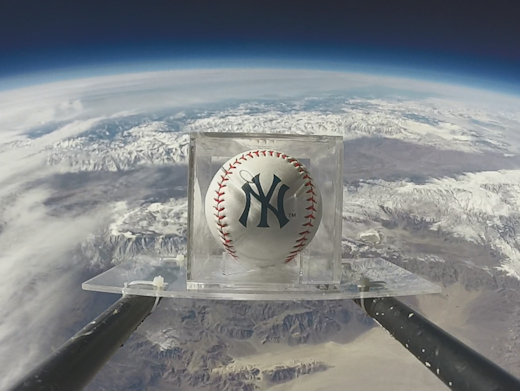
You can have it for $99.95. The students are selling space baseballs to support their cosmic ray ballooning program. Each ball comes with a greeting card showing the ball in flight and telling the story of its journey to the edge of space. Not a Yankees fan? No problem. We also offer space baseballs for the Dodgers, Red Sox, Astros, Giants, Cardinals, Cubs, Braves, Royals, Brewers, Phillies, Padres, Angels and more. Just let us know your favorite team and we'll fly it if we don't already have it. Far Out Gifts: Earth to Sky Store
All sales support hands-on STEM education
Realtime Aurora Photo Gallery
Free: Spaceweather.com Newsletter
Every night, a network of NASA all-sky cameras scans the skies above the United States for meteoritic fireballs. Automated software maintained by NASA's Meteoroid Environment Office calculates their orbits, velocity, penetration depth in Earth's atmosphere and many other characteristics. Daily results are presented here on Spaceweather.com. On May. 17, 2019, the network reported 10 fireballs.
(10 sporadics) 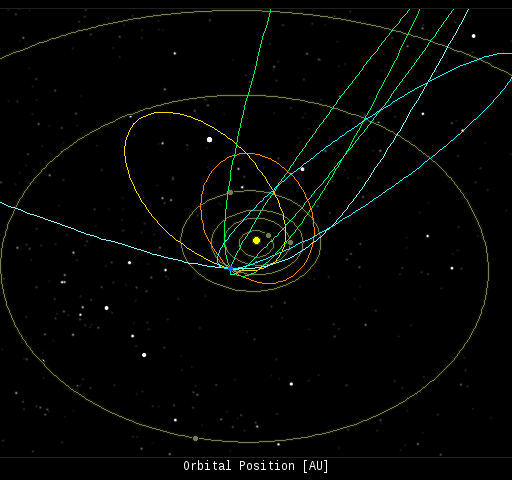 In this diagram of the inner solar system, all of the fireball orbits intersect at a single point--Earth. The orbits are color-coded by velocity, from slow (red) to fast (blue). [Larger image] [movies] Potentially Hazardous Asteroids ( PHAs) are space rocks larger than approximately 100m that can come closer to Earth than 0.05 AU. None of the known PHAs is on a collision course with our planet, although astronomers are finding new ones all the time. On May 17, 2019 there were 1983 potentially hazardous asteroids.
 | Recent & Upcoming Earth-asteroid encounters: | Asteroid | Date(UT) | Miss Distance | Velocity (km/s) | Diameter (m) | | 2019 JL | 2019-May-12 | 14.3 LD | 9.2 | 21 | | 2018 VX8 | 2019-May-12 | 6.2 LD | 15.5 | 118 | | 2019 JO2 | 2019-May-12 | 3.7 LD | 10.8 | 26 | | 2019 JM3 | 2019-May-12 | 10.8 LD | 20.3 | 36 | | 2019 JR5 | 2019-May-13 | 11.1 LD | 25 | 41 | | 2019 JK3 | 2019-May-13 | 3.2 LD | 10.7 | 16 | | 2019 JW5 | 2019-May-13 | 2.3 LD | 11.5 | 12 | | 2019 JO3 | 2019-May-14 | 18.5 LD | 10.8 | 47 | | 2019 JN2 | 2019-May-15 | 7.1 LD | 6.8 | 26 | | 2019 JN5 | 2019-May-16 | 4.4 LD | 13.1 | 28 | | 2019 JH7 | 2019-May-16 | 0.2 LD | 9.6 | 4 | | 2019 JG1 | 2019-May-17 | 5.6 LD | 8.1 | 17 | | 2012 KT12 | 2019-May-17 | 4.2 LD | 4 | 20 | | 2019 GT1 | 2019-May-17 | 6.1 LD | 3.9 | 36 | | 2019 JR1 | 2019-May-18 | 16.2 LD | 10 | 44 | | 2019 JB1 | 2019-May-20 | 16.8 LD | 26 | 233 | | 2019 JL3 | 2019-May-20 | 2.5 LD | 8.8 | 37 | | 2019 JF7 | 2019-May-24 | 14.7 LD | 10.9 | 37 | | 2015 KQ18 | 2019-May-25 | 10.7 LD | 13.1 | 30 | | 66391 | 2019-May-25 | 13.5 LD | 21.5 | 1780 | | 2003 LH | 2019-May-28 | 15.6 LD | 7.4 | 32 | | 2011 HP | 2019-May-30 | 12.3 LD | 8.4 | 135 | | 2019 JX2 | 2019-Jun-06 | 13.8 LD | 7 | 44 | | 2014 MF18 | 2019-Jun-06 | 8.8 LD | 3 | 22 | | 441987 | 2019-Jun-24 | 7.7 LD | 12.6 | 178 | | 2008 KV2 | 2019-Jun-27 | 17.8 LD | 11.4 | 195 | | 2016 NN15 | 2019-Jun-28 | 9.6 LD | 8.4 | 16 | | 2015 XC352 | 2019-Jul-01 | 11.9 LD | 4.1 | 26 | | 2016 OF | 2019-Jul-07 | 12.8 LD | 8.5 | 85 | | 2016 NO56 | 2019-Jul-07 | 3.4 LD | 12.2 | 26 | | 2016 NJ33 | 2019-Jul-12 | 15 LD | 4.5 | 32 | Notes: LD means "Lunar Distance." 1 LD = 384,401 km, the distance between Earth and the Moon. 1 LD also equals 0.00256 AU. MAG is the visual magnitude of the asteroid on the date of closest approach. | | Cosmic Rays in the Atmosphere | SOMETHING NEW! We have developed a new predictive model of aviation radiation. It's called E-RAD--short for Empirical RADiation model. We are constantly flying radiation sensors onboard airplanes over the US and and around the world, so far collecting more than 22,000 gps-tagged radiation measurements. Using this unique dataset, we can predict the dosage on any flight over the USA with an error no worse than 15%. E-RAD lets us do something new: Every day we monitor approximately 1400 flights criss-crossing the 10 busiest routes in the continental USA. Typically, this includes more than 80,000 passengers per day. E-RAD calculates the radiation exposure for every single flight. The Hot Flights Table is a daily summary of these calculations. It shows the 5 charter flights with the highest dose rates; the 5 commercial flights with the highest dose rates; 5 commercial flights with near-average dose rates; and the 5 commercial flights with the lowest dose rates. Passengers typically experience dose rates that are 20 to 70 times higher than natural radiation at sea level. To measure radiation on airplanes, we use the same sensors we fly to the stratosphere onboard Earth to Sky Calculus cosmic ray balloons: neutron bubble chambers and X-ray/gamma-ray Geiger tubes sensitive to energies between 10 keV and 20 MeV. These energies span the range of medical X-ray machines and airport security scanners. Column definitions: (1) The flight number; (2) The maximum dose rate during the flight, expressed in units of natural radiation at sea level; (3) The maximum altitude of the plane in feet above sea level; (4) Departure city; (5) Arrival city; (6) Duration of the flight. SPACE WEATHER BALLOON DATA: Approximately once a week, Spaceweather.com and the students of Earth to Sky Calculus fly space weather balloons to the stratosphere over California. These balloons are equipped with radiation sensors that detect cosmic rays, a surprisingly "down to Earth" form of space weather. Cosmic rays can seed clouds, trigger lightning, and penetrate commercial airplanes. Furthermore, there are studies ( #1, #2, #3, #4) linking cosmic rays with cardiac arrhythmias and sudden cardiac death in the general population. Our latest measurements show that cosmic rays are intensifying, with an increase of more than 18% since 2015: 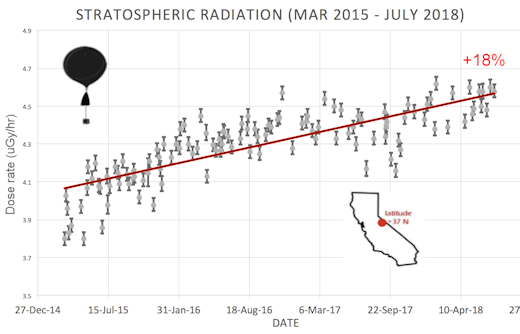
The data points in the graph above correspond to the peak of the Reneger-Pfotzer maximum, which lies about 67,000 feet above central California. When cosmic rays crash into Earth's atmosphere, they produce a spray of secondary particles that is most intense at the entrance to the stratosphere. Physicists Eric Reneger and Georg Pfotzer discovered the maximum using balloons in the 1930s and it is what we are measuring today. En route to the stratosphere, our sensors also pass through aviation altitudes: 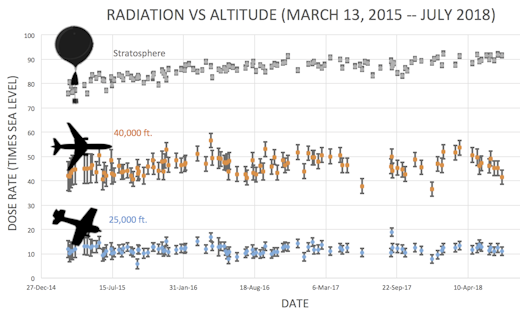
In this plot, dose rates are expessed as multiples of sea level. For instance, we see that boarding a plane that flies at 25,000 feet exposes passengers to dose rates ~10x higher than sea level. At 40,000 feet, the multiplier is closer to 50x. The radiation sensors onboard our helium balloons detect X-rays and gamma-rays in the energy range 10 keV to 20 MeV. These energies span the range of medical X-ray machines and airport security scanners. Why are cosmic rays intensifying? The main reason is the sun. Solar storm clouds such as coronal mass ejections (CMEs) sweep aside cosmic rays when they pass by Earth. During Solar Maximum, CMEs are abundant and cosmic rays are held at bay. Now, however, the solar cycle is swinging toward Solar Minimum, allowing cosmic rays to return. Another reason could be the weakening of Earth's magnetic field, which helps protect us from deep-space radiation. | | The official U.S. government space weather bureau | | | The first place to look for information about sundogs, pillars, rainbows and related phenomena. | | | Researchers call it a "Hubble for the sun." SDO is the most advanced solar observatory ever. | | | 3D views of the sun from NASA's Solar and Terrestrial Relations Observatory | | | Realtime and archival images of the Sun from SOHO. | | | from the NOAA Space Environment Center | | | fun to read, but should be taken with a grain of salt! Forecasts looking ahead more than a few days are often wrong. | | | from the NOAA Space Environment Center | | | the underlying science of space weather |  | To find reviews of new online casino sites in the UK try The Casino DB where there are hundreds of online casino reviews complete with bonuses and ratings. Looking for a new online casino? Try Casimpo the new site dedicated to making online casino simple and easy for all. | | | These links help Spaceweather.com stay online. Thank you to our supporters! | | | | | | | | |  | |  |   | ©2018 Spaceweather.com. All rights reserved. This site is penned daily by Dr. Tony Phillips. | |

